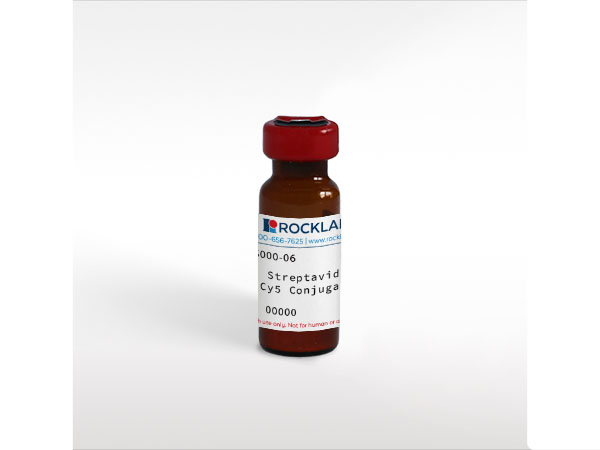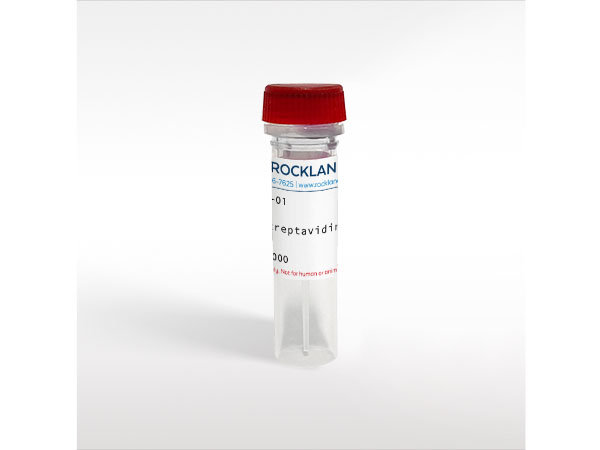Streptavidin: Properties and Applications
Streptavidin is a biotin-binding protein found in the culture broth of the bacterium Streptomyces avidinii. Like its namesake, avidin, streptavidin binds 4 moles of biotin per mole of protein with a high affinity virtually unmatched in nature (Kd 10-15 M).
Avidin vs Streptavidin
Avidin is a tetrameric biotin-binding glycoprotein with a molecular weight (MW) of approximately 62.4 kDa. Streptavidin is a slightly smaller molecule with a MW of approximately 53.6 kDa. The sequence of avidin only shows 30% homology with streptavidin, and anti-avidin and anti-streptavidin antibodies are not immunologically cross-reactive.
Streptavidin has identical biotin-binding properties compared with avidin, but lacks the glycoprotein portion of the molecule. Streptavidin has an isoelectric point nearer to neutrality, where most useful biological interactions occur (pI of 5-6 vs. 10 for avidin). As a result, streptavidin frequently exhibits lower levels of non-specific binding than does avidin when the proteins are used in applications relying upon the formation of avidin/biotin complexes.1
Applications in Diagnostics
In ELISA-based diagnostic systems, antibodies directed against a particular antigen may be covalently attached to reporter enzymes. Antigens are then quantitated by enzymatic assay after binding to these conjugated molecules. Unfortunately, the precise conditions for accomplishing such covalent attachments must be determined individually for each antibody/reporter combination, and often result in significant loss of either the enzymatic activity of the reporter enzyme or the binding functions of the antibodies. Streptavidin finds utility in these systems because antibody molecules are easily modified by the covalent attachment of derivatives of biotin with little or no loss in the ability of the antibody molecules to bind their antigens. These biotinylated antibodies may be detected by their interaction with conjugates of streptavidin and the reporter enzymes.2 The same preparation of conjugated streptavidin-reporter enzyme may be used with any number of different biotinylated antibodies, making this system a highly flexible one.
The reporter molecule may be bound to streptavidin covalently, or biotinylated and attached to streptavidin via the streptavidin-biotin interaction. Since streptavidin is multivalent (binding 4 molecules of biotin per tetrameric protein molecule), it may be used in combination with biotinylated antibodies and biotinylated reporter enzymes to obtain amplified signals. Such amplification in ELISAs is otherwise difficult to obtain and requires the introduction of additional antibody components. ELISA systems employing streptavidin can readily detect sub-nanogram amounts of antigens.
Molecular Structure and Characteristics
The molecular weight of streptavidin is 55,000 daltons. The protein is composed of 4 essentially identical polypeptide chains (homotetramer). The protein contains no cysteine residues, carbohydrate side chains, or associated cofactors. Different preparations of streptavidin show considerable heterogeneity at both the amino- and carboxy-termini of each subunit polypeptide due to proteolysis during biosynthesis and secretion. Monomeric subunits of streptavidin are synthesized as 183 amino acid prepeptides. During secretion by Streptomyces sp., a 24 amino acid leader sequence is cleaved from these polypeptides, resulting in newly secreted monomers of 159 amino acids.3 Upon longer incubations in culture, these monomers are progressively cleaved to "core" subunits containing 125-127 amino acids.4 Preparations of streptavidin are relatively stable over a wide pH range and extremely heat stable, requiring up to 20 minutes at 100°C in 0.2% SDS to dissociate the subunits.5 Strong chaotropic agents such as 6 M urea have been reported to dissociate the streptavidin tetramer into dimers.6 These dimers appear to be stable in urea without the appearance of monomers. Unproteolyzed and proteolyzed preparations of streptavidin appear to bind biotin with equal affinity. The most highly proteolyzed tetramers may bind over 16 micrograms of d-biotin per milligram of protein. Bayer (1989) reports that biotinylated enzymes bind most effectively to truncated streptavidin in ELISA-type assays.
Stability and Binding Efficiency
The dissociation constant (Kd) for biotin is approximately 10-15 M.1 The formation of the streptavidin-biotin complex is stable over wide pH and temperature ranges. The complex is generally disrupted only by conditions that lead to the irreversible denaturation of the protein. Analogs of biotin such as 2-imino-biotin bind reversibly to the protein, with complex formation at high pH (>9.5) and dissociation at low pH (<4).5,7 The extinction coefficient of streptavidin is E(0.1% at 280 nm): 3.17.8
In conclusion, streptavidin's unique properties make it a pivotal tool in scientific research and diagnostics. Its capacity to form stable, high-affinity complexes with biotin under diverse conditions underscores its versatility and indispensable role in biochemical applications.
Featured Streptavidin Products



